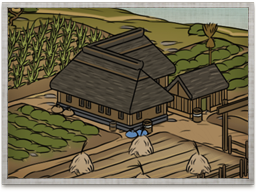Difference between revisions of "Terrace Farming (TWS2)"
(Created page with " {{TWS2 Building|image=Image:Terrace Farming S2TW.png |Chain=Farming Type |Requires='''Buildings''':<li>[[Improved Irrigation (TWS...") |
|||
| (One intermediate revision by the same user not shown) | |||
| Line 1: | Line 1: | ||
{{TWS2 Building|image=[[Image:Terrace Farming S2TW.png]] | {{TWS2 Building|image=[[Image:Terrace Farming S2TW.png]] | ||
|Chain=[[:Category:TWS2_Building#Farming_Chain|Farming Type]] | |Chain=[[:Category:TWS2_Building#Farming_Chain|Farming Type]] | ||
| − | |Requires='''Buildings''':<li>[[Improved Irrigation (TWS2)|Improved Irrigation]]</li>'''Arts''':<li>[[Equal Fields]]</li> | + | |Requires='''Buildings''':<li>[[Improved Irrigation (TWS2)|Improved Irrigation]]</li> |
| + | '''Arts''':<li>[[Equal Fields]]</li> | ||
|Enables='''Buildings''':<li>[[Land Consolidation (TWS2)|Land Consolidation]]</li> | |Enables='''Buildings''':<li>[[Land Consolidation (TWS2)|Land Consolidation]]</li> | ||
|Spawned Defence Forces=- | |Spawned Defence Forces=- | ||
| − | |Basic Building Statistics=<li>+850 to wealth from farms in this province</li><li>Provides food: 3</li> | + | |Basic Building Statistics=<li>Cost: 1950</li> |
| + | <li>+850 to wealth from farms in this province</li> | ||
| + | <li>Provides food: 3</li> | ||
|Clan Effects=-}} | |Clan Effects=-}} | ||
==Description== | ==Description== | ||
| − | + | '''The foundation of wealth is a full rice bowl.''' | |
| − | + | Terrace farming increases the amount of land that can be cultivated, and so adds to the wealth and potential tax income of a province. Eventually farmers will use every square inch of level land available, at which point they must make more. By carefully shaping the hills into a series of giant steps, new land can be created that is suitable for farming. Each step becomes a new, ribbon-shaped paddy field that hugs the contours of a hill. If this is done cunningly and there is little point doing otherwise water is used and re-used as it flows downhill over the terraces. | |
| − | + | Terrace farming is used in many parts of the world with mountainous landscapes. The landscape is carefully formed into a system of contour-following platforms, with water cascading down from the highest level to the lowest. The result is an extremely efficient use of available space, even where paddy fields are not used; in the Andes of South America terraces were used for virtually all crops, for example. The result is also extremely picturesque, and an impressive piece of human, manual landscaping. The technique still finds favour today because it can stop heavy erosion and help prevent landslides as well as being an effective agricultural method. | |
[[Category:TWS2 Building]] | [[Category:TWS2 Building]] | ||
Latest revision as of 03:15, 19 January 2013
| Terrace Farming (TWS2) | |
|---|---|
 | |
| Chain | Farming Type |
| Requires | Buildings: |
| Enables | Buildings: |
| Spawned Defence Forces | - |
| Basic Building Statistics | |
| Clan Effects | - |
| See main article; FotS Buildings | |
Description
The foundation of wealth is a full rice bowl.
Terrace farming increases the amount of land that can be cultivated, and so adds to the wealth and potential tax income of a province. Eventually farmers will use every square inch of level land available, at which point they must make more. By carefully shaping the hills into a series of giant steps, new land can be created that is suitable for farming. Each step becomes a new, ribbon-shaped paddy field that hugs the contours of a hill. If this is done cunningly and there is little point doing otherwise water is used and re-used as it flows downhill over the terraces.
Terrace farming is used in many parts of the world with mountainous landscapes. The landscape is carefully formed into a system of contour-following platforms, with water cascading down from the highest level to the lowest. The result is an extremely efficient use of available space, even where paddy fields are not used; in the Andes of South America terraces were used for virtually all crops, for example. The result is also extremely picturesque, and an impressive piece of human, manual landscaping. The technique still finds favour today because it can stop heavy erosion and help prevent landslides as well as being an effective agricultural method.